Palestinian cuisine comprises a set of skills, knowledge, practices, and traditions that range from nature to the dining place. This includes crops, their harvesting, processing, and conservation, fishing, and the preparation and, particularly, the consumption of food. The Gaza diet is considered a sub-traditional food characterized by a nutritional model that has remained constant over time and space, consisting mainly of olive oil, fresh or dried vegetables, fish, cereals, dairy, meat, spices, and condiments, all complemented by the special kanafa of Gaza (a dessert made with sweet cheese).
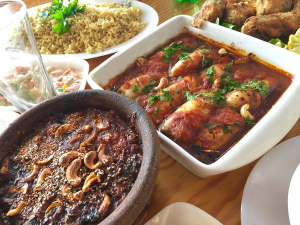
The Gaza diet, however, encompasses more than just food. It has a social meaning and promotes social interaction as families gather to consume communal meals that are the cornerstone of social customs and family occasions. Such events have given rise to a considerable body of knowledge that includes traditional songs, tales, and legends. The system is rooted in respect for the natural landscape and biodiversity, and it safeguards the conservation and development of traditional activities and crafts linked to fishing and farming in the Gaza region. Women play a particularly vital role in the conservation and transmission of the expertise, knowledge, and techniques associated with this culinary culture.
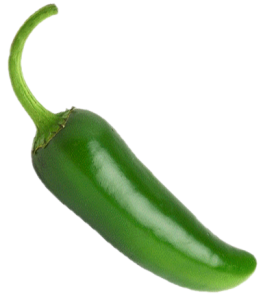
Gaza’s diet strengthens the relation between those who have expertise and those who learn with constancy and dedication. Traditional food has intrinsic meaning that is passed down from hand to hand and from mouth to ear. It is infinitely played out in a staging and conservation of the socio-cultural traditions. Stories and tales that accompany traditional meals have become fully part of Gaza’s cultural heritage.
A traditional Gaza meal consists of dishes that are commonly eaten also by Palestinians living in the West Bank. As mentioned above, the Palestinian diet has been formed and influenced by the cultures and civilizations that settled in this region, particularly during and after the Islamic periods that culminated in the strong influence of Turkish cuisine. It is similar to other Levantine cuisines, including that of Lebanon, Syria, and Jordan.
Cooking styles in Palestine vary by region due to the various climates and landscapes, and each cooking style and the ingredients used are generally based on the climate and traditions of the particular region. The Gaza diet is a variation of Levantine cuisine, but it is more diverse in its inclusion of seafood and use of spices. Gaza’s inhabitants consume great quantities of chili peppers (shatta). Meals are usually eaten in the household, but dining out has become prevalent particularly for parties that offer light meals that generally include salads (salata ghazawiyya), pita bread (saj), and skewered meats. Hot chili, garlic, and dill make up the basic Gazan spice combination.
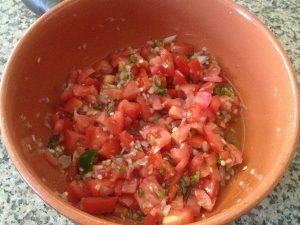
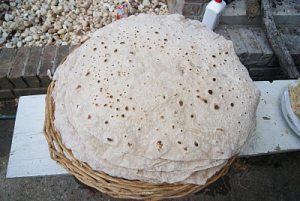
Gaza is home to many traditional fish dishes that form an essential part of the Gazan social and cultural environment. Sayadiyya, (fishermen’s delight) and zibdiyyit gambari (shrimp stew) are among the traditional fish dishes in Gaza.
Sayadiyya is typical of the Levant coastline cuisine and features fish fillets delicately spiced with garlic, dill, chili peppers, and a touch of red-hot cayenne pepper and fried in virgin olive oil, which gives it its unique taste. The fish is served with fried onions and rice. Referred to as “fisherman’s food,” sayadiyya is a very popular dish in Gaza. Hamour or any other white fish can be prepared in this way.
Zibdiyyit gambari is considered a typical Gazan dish of peeled shrimp, tomatoes, green bell peppers, and onions sautéed in olive oil, all stewed in a zibdiyya, a traditional small clay bowl that is also used to serve the dish. The spices include dill and garlic, crushed chili peppers, toasted pine nuts, and sesame seeds.
Salata ghazawiyya (Gazan salad) is served in a zibdiyya and consists of crushed garlic, crushed tomatoes, finely diced green bell peppers, a little salt, and dried dill. Ghazawiyya salad is generously topped with olive oil and green dill and served with flatbread for dipping.

Saj bread is an old tradition in Palestinian cuisine and remains an important staple for Gazans. It is a key ingredient for some Middle Eastern dishes such as fatteh ghazawiyya, which is a popular dish served on Fridays and on special occasions. Saj bread dough is made by mixing flour, salt, and lukewarm water; the dough is then kneaded until it is soft and sticky. Small balls of dough are then repeatedly and quickly flipped and tossed until they are large and thin. The baker transfers them, using a small cushion, to a convex metal plate where they are baked only for a few seconds before they are ready to be served.
Gaza is also home to many desserts that range from those made regularly to those that are commonly reserved for the holidays. Most Palestinian sweets are pastries filled with either sweetened cheese, dates, or various nuts such as almonds, walnuts, or pistachios.
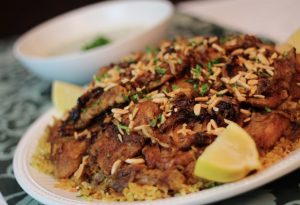
Among these, none is as splendid, or as uniquely Gazan, as kanafa arabiyya or kanafa ghazawiyya. While kanafa is a broad category of desserts made throughout the region, kanafa arabiyya is the unique sweet of Gaza. This variety of kanafa was originally popular throughout the coastal areas of Palestine, but after the occupation, when many of the refugees from the coastal cities ended up in Gaza, this kanafa became known as the Gazan or Arabic kanafa. It is rougher and more rustic compared to other kanafas in Palestine. It is also richer, and its flavors run deeper with the taste of cinnamon and walnuts, which plays beautifully on the canvas of rich and buttery dough baked into a crust, a nutty filling with subtle notes of cinnamon and orange-blossom water. It is utterly and completely addictive.
Palestinian traditional food constitutes a historical passport, a connection to our past as the indigenous people of Palestine, reflecting our historical rights to our land.
Traditional food, as intangible cultural heritage, is as important as any historical monument. And whereas many Palestinians recognize their cultural heritage and protect traditional foods, such efforts must be supported and could be increased. The Palestinian traditional sweet kanafa nabulsiyya is as worthy of preserving as the old city of Nablus.


